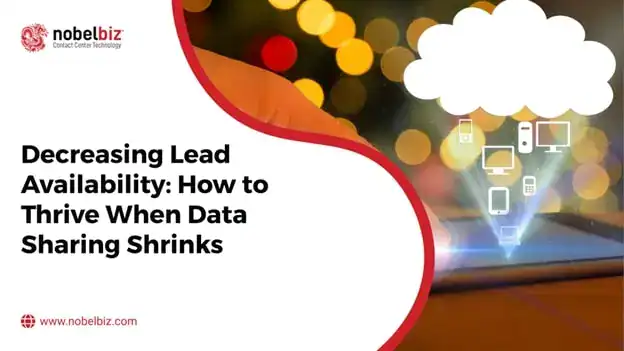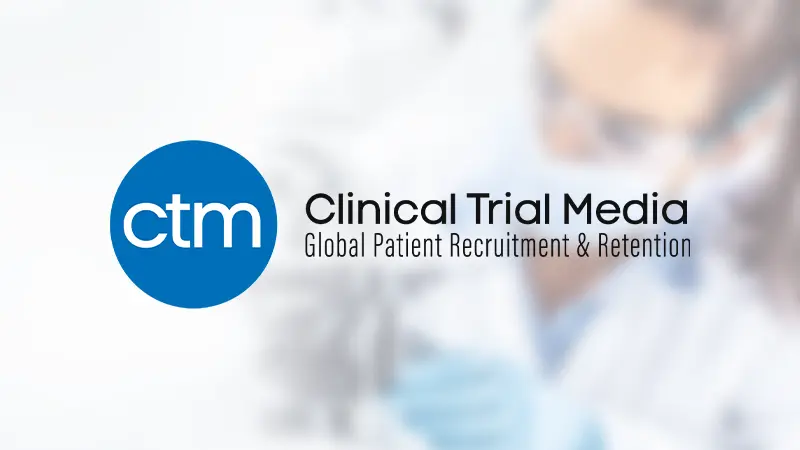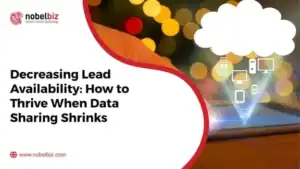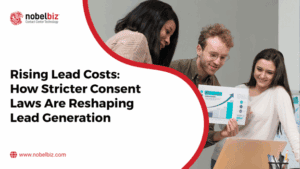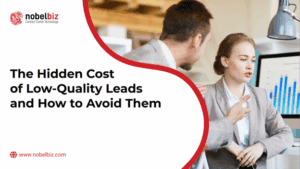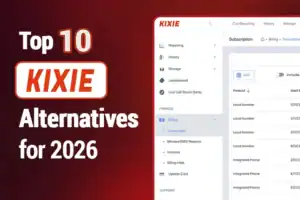In 2025, outbound contact centers are facing a new challenge: shrinking access to lead data.
With third-party cookies disappearing, stricter consent laws, and consumers sharing less personal information, call centers must learn to do more with less—using first-party data, consent-driven outreach, and innovative compliance tools to keep their pipelines full.
- Lead availability is shrinking: Privacy laws, cookie deprecation, and consumer caution limit data sharing and outbound access.
- Shift to first-party and zero-party data: Call centers must build compliant, high-quality databases sourced directly from customer interactions.
- Compliance-first frameworks matter: Under TCPA, GDPR, and CCPA, they are essential to sustain trust, visibility, and outreach efficiency.
- Technology drives efficiency: AI, analytics, and consent management tools help call centers maximize smaller datasets and improve targeting accuracy.
- Quality beats quantity: Success depends on verified leads, transparent consent, and precision-driven outreach rather than bulk dialing.
- Sustainable lead generation means adaptation: Call centers that utilize compliance, automation, and first-party data will remain competitive in a privacy-first market.
Data privacy laws, cookie deprecation, and limits on data sharing have fundamentally changed how businesses find and connect with customers.
At the same time, regulations like GDPR and CCPA continue to restrict how contact data can be collected, stored, and shared. According to the IAPP Privacy Risk Study 2023, noncompliant third-party data processing is now one of the top privacy risk areas for organizations worldwide.
For contact centers, these changes bring rising acquisition costs, stricter consent requirements, and increased operational complexity. The era of bulk calling from purchased lists is coming to an end.
This blog explores how contact centers can adapt to decreasing lead availability by utilizing first-party and consent-driven strategies, investing in more innovative technology, and building sustainable lead pipelines that prioritize quality over quantity.
“The winners in 2025 won’t be the teams with the biggest lists, but the ones with the cleanest consent and smartest use of first-party data—compliance is now your growth engine, not a checkbox.” – Christian Montes, Chief Operating Officer at NobelBiz
Core Operational Challenges in Call Center Lead Generation

As data availability declines and compliance standards tighten, call centers face mounting operational barriers that directly affect outreach efficiency and conversion performance. Below are the most pressing challenges reshaping how call centers source, manage, and convert leads today.
Declining Connect Rates from Smaller Lead Pools: With fewer leads available due to privacy restrictions and limited data sharing, conversion rates are steadily declining. Agents are making more calls to reach fewer people, which increases time per conversion and lowers overall productivity.
For call centers, smaller lead pools mean more reliance on accurate data segmentation, efficient dialing modes, and real-time visibility to maintain outreach effectiveness.
Higher Cost per Qualified Lead: The cost of acquiring verified, consented data continues to rise. Stricter regulations and limited data resale options make each qualified lead more expensive.
Call centers now spend more on compliant sourcing, CRM tools, and validation systems to maintain data accuracy. This shift makes lead quality and prioritization essential to sustaining profitability.
Difficulty Sourcing Compliant Data for Outbound Campaigns: Finding compliant data for outbound campaigns is increasingly complex. Many traditional data providers can no longer guarantee full TCPA, GDPR, or CCPA compliance.
Call centers must verify every record before use, which slows campaign launches and reduces outreach volume. The focus is moving from list quantity to consent validation and secure data handling.
Privacy Regulations Limiting Data Resale: Modern privacy regulations limit data resale between third-party vendors. Data once shared freely across networks now requires explicit user consent and detailed compliance documentation.
For call centers, this limits access to large-scale purchased lists and pushes teams toward building first-party databases through inbound activity and direct engagement.
Carrier Filtering and Consent Verification Challenges: Carrier filtering and consent verification have become critical hurdles for outbound dialing. Carriers increasingly block or label calls that lack verified consent or proper Caller ID alignment.
Call centers must maintain accurate consent records, use localized Caller ID systems, and monitor call reputation to protect deliverability and sustain trust.
Scaling Lead Generation Without Third-Party Lists: Scaling outreach without third-party lead lists requires a complete operational shift. Call centers can no longer depend on volume-based dialing to fill pipelines.
Instead, growth now depends on first-party and zero-party data, CRM integration, and AI-driven segmentation to efficiently and compliantly identify high-intent prospects.
Salman Aslam
Director Support – Quality & Training at WORK Inc.
‘The support team at Nobelbiz understood our business requirements and we we’re able to push through seamlessly’
The Shrinking Data Reality for Call Centers
The table below summarizes how third-party lead lists, cookie-based tracking, and declining data sharing in marketing are reshaping lead generation in 2025.
| Data Source Type | 2018–2020 Availability | 2025 Status | Operational Impact for Call Centers |
|---|---|---|---|
| Third-party lead lists | Widespread | Heavily restricted | Harder to scale outbound efforts |
| Cookie-based tracking | Universal | Deprecated (Google 2025) | Loss of behavioral targeting |
| Consumer data sharing | ~75% in 2018 | ~52% in 2024 | Fewer opt-ins for TCPA-compliant campaigns |
| First-party consent data | Limited use | Core strategy | Improved deliverability & compliance |
Brayan Carpio
Senior Call Center Manager, Call4You Marketing
‘The technology aspect of NobelBiz stood out compared to the competition, and also the great team! All the way from onboarding to support to troubleshooting has been great throughout this journey!’
Why Lead Availability Is Shrinking for Call Centers?
The most significant factor behind declining data access in call centers is the combination of evolving privacy laws and reduced third-party sharing. Understanding why call centers are getting fewer leads in 2025 starts with how new privacy laws and cookie deprecation have limited data collection and sharing.
How Data Privacy Laws Like GDPR, TCPA, and State Bills Reduce Lead Volume?
Over the past few years, data privacy laws such as GDPR, TCPA, and new state-level bills have tightened how businesses collect, store, and use personal information. These regulations require explicit consent before any outreach, effectively reducing the number of legally reachable prospects.
For call centers, this creates clear operational challenges:
- Purchased or shared contact lists are often incomplete or non-compliant.
- Data brokers face restrictions on how they can resell or share lead information.
- Verification and documentation requirements add new layers of process before dialing can begin.
Lead volume will continue to decline as compliance standards grow more rigorous. To remain effective, call centers must transition from third-party lists to first-party, consent-driven data, collected directly through inbound inquiries, web forms, and existing customer interactions.
Why Consumers Are Less Willing to Share Personal Data, Limiting Compliant Leads?
Even when regulations permit data collection, consumer trust remains a major barrier. According to Cisco’s 2024 Data Privacy Survey, 52% of consumers are willing to share personal data, down from 75% in 2018 .
This shift reflects growing concern about data misuse, spam calls, and unauthorized sharing. For call centers, the impact is tangible:
- Fewer people are opting in to marketing or contact forms.
- Consent rates drop across outbound and remarketing campaigns.
- Agents face higher call rejection rates and more hang-ups due to low trust.
Rebuilding consumer confidence is essential. Call centers should communicate transparency, explain how data will be used, and ensure every interaction adds value, whether through personalized assistance, clear opt-in choices, or post-call follow-ups that demonstrate respect for privacy.
The Impact on Outbound Call Center Operations
As data regulations tighten and consumer sharing habits decline, outbound call centers face mounting pressure to maintain performance with smaller, more regulated lead pools. These shifts have redefined how call center lead generation functions, from sourcing and verification to compliance and outreach performance.
Why Smaller Lead Pools Mean Higher Cost per Qualified Contact?
With lead availability declining, outbound teams are competing for fewer verified contacts. This scarcity drives up the cost per qualified lead, as compliant data lists and verified contacts now require more resources to source and maintain.
In a recent study, 61% of businesses said that generating high-quality leads is their biggest challenge . For call centers, this challenge is amplified because each contact must meet both quality and compliance standards.
Significant impacts on outbound operations include:
- Increased spending on compliant data providers and CRM verification tools.
- Fewer leads are entering the funnel, requiring higher conversion rates to maintain ROI.
- Greater emphasis on lead scoring and prioritization to allocate agent time efficiently.
Smaller lead pools mean every connection matters. To maintain profitability, call centers must optimize for lead quality over volume, focus on precise targeting, and leverage technology to reduce wasted dials.
How Lower Data Availability Hurts Contact Rate and Connect Rate?
The loss of third-party data and reduced consumer opt-ins have also lowered contact and connect rates across outbound campaigns . With fewer valid numbers and less behavioral data available, agents often spend more time calling unresponsive or outdated leads. Implementing strategies to maintain contact rates with fewer leads requires better data validation, intelligent dialing tools, and precise segmentation.
For call centers, this translates to:
- Lower daily contact ratios and fewer meaningful conversations.
- Reduced efficiency per agent as more dials are needed to achieve the same results.
- Greater pressure on dialing strategies and technology to maximize limited data.
Maintaining strong connect rates now depends on data accuracy, dialing strategy, and call timing. Tools like smart dialers, LocalTouch Caller ID, and AI-based segmentation can help improve connection success by ensuring agents reach the right people at the right moment.
The Double Challenge: Maintaining Compliance and Agent Efficiency
Outbound operations face a dual challenge: staying compliant while keeping agents productive. Regulations such as TCPA, GDPR, and state privacy laws require proof of consent, call tracking, and accurate opt-out management. Compliance processes, while necessary, can slow down outreach if not automated.
For call centers, this often results in:
- Reduced dialing speed due to consent verification and filtering.
- Increased administrative work for compliance documentation.
- Balancing legal safety with consistent performance metrics.
Efficiency and compliance can coexist, but only with the right systems in place. By adopting integrated compliance filters, consent management platforms (CMPs), and CRM automation, call centers can maintain regulatory confidence while preserving productivity.
Clinical Trial Media
Mo Pene |
Contact Center Technology Manager @ CTM
‘Thanks to NobelBiz, we now enjoy a robust, scalable communication system tailored to our growing needs, empowering us to deliver personalized care experiences more efficiently and boosting our overall revenue.’
Thriving Despite Shrinking Data Sharing
As data-sharing restrictions grow tighter and third-party lists become less reliable, call centers must learn to do more with less. Sustainable call center lead generation now depends on the ability to use smaller, high-quality data sets effectively. Learning how to generate leads when data sharing shrinks is now a top priority for outbound teams facing reduced list sizes and stricter compliance.
How to Use First-Party Data to Replace Third-Party Leads?
The decline of third-party lead access has forced a shift toward first-party data, information collected directly from customers through calls, website interactions, or CRM updates. Unlike purchased data, first-party insights are more accurate, compliant, and aligned with actual customer intent. Emphasizing first-party data for call center lead gen helps teams build reliable, compliant databases that perform better over time.
For call centers, this approach provides measurable advantages:
- Data quality is higher because it’s verified directly at the source.
- Leads are inherently compliant since users provided information voluntarily.
- Outreach can be personalized using real behavioral and interaction data.
Building and maintaining strong first-party databases ensures a sustainable and compliant lead supply. Every inbound call, form submission, or live chat should feed directly into the CRM, creating a living system of qualified, traceable leads that grow over time.
Utilizing Consent-Driven Opt-Ins Through IVR, SMS, and Web Forms
With fewer third-party options, call centers must focus on consent-driven lead generation, capturing customer interest through IVR prompts, SMS outreach, or secure web forms. These channels make it easy to request permission while collecting essential details. By using first-party and zero-party data in lead generation campaigns, call centers can build permission-based databases that scale sustainably.
Practical methods include:
- Using IVR surveys to ask customers for call-back consent.
- Sending opt-in SMS messages for follow-up communications.
- Embedding clear consent language in all web and contact forms.
Every new contact point should double as a consent opportunity. By integrating opt-ins directly into engagement workflows, call centers can expand lead databases safely and maintain transparency with regulators and consumers alike.
The Role of First-Contact Routing in Maximizing Limited Lead Data
When lead volume is low, routing efficiency becomes a key performance factor. First-contact routing ensures each incoming lead or inquiry reaches the most suitable agent on the first attempt, improving both response time and conversion probability.
In practice, effective routing helps reduce missed opportunities by connecting prospects quickly and matching leads with agents experienced in their specific needs or product area. Optimize limited lead data by ensuring every valid contact receives timely attention.
Smaller lead pools leave little room for wasted interactions. Implementing intelligent routing systems ensures that every valid lead is handled by the right person at the right moment, maximizing outcomes from limited data resources.
How to Train Agents to Identify and Prioritize High-Intent Prospects?
As data availability decreases, agents must compensate by becoming more skilled at recognizing high-intent prospects. This means identifying behavioral and verbal cues that signal readiness to engage or buy, even when lead information is limited.
Essential training areas include:
- Recognizing keywords or phrases that indicate buying intent.
- Using CRM notes to understand past interactions before the first call.
- Prioritizing callbacks or follow-ups based on recency and engagement patterns.
An informed, proactive agent team can turn a shrinking lead database into a productive pipeline. Consistent training, combined with AI-supported lead scoring, helps agents focus energy where it matters most, improving conversion rates without expanding list size.
Compliance-First Lead Generation for Call Centers
As privacy and communication regulations evolve, call centers must prioritize compliance to maintain performance and trust. Building a compliance-first lead generation framework is now essential, not only to meet legal requirements but also to preserve deliverability, caller reputation, and conversion efficiency. Strong governance over data privacy in outbound dialing ensures every contact is both compliant and credible, protecting brand reputation and connect rates.
How TCPA, STIR/SHAKEN, and Carrier Reputation Affect Dialing Strategies?
The impact of the TCPA and GDPR on lead availability is clear: stricter consent verification has reduced accessible contacts while improving overall data integrity. Regulations such as the Telephone Consumer Protection Act (TCPA) and authentication protocols like STIR/SHAKEN have transformed how outbound dialing can be executed. These rules protect consumers from unwanted or fraudulent calls but also place stricter controls on legitimate contact center operations.
For call centers, this means:
- Each outbound call must have documented consent and follow time-of-day restrictions.
- STIR/SHAKEN verification ensures calls are authenticated and not flagged as spam.
- Carrier reputation management determines whether calls reach the recipient or are blocked.
These factors directly impact connect rates and agent efficiency. Even compliant teams can experience call delivery issues if numbers lack authentication or have poor reputation scores.
Dialing strategies must now integrate compliance validation, number reputation tracking, and carrier trust monitoring. A proactive approach ensures calls are delivered consistently and remain fully compliant under TCPA and related frameworks. Call center compliance and data privacy challenges will continue to evolve, but proactive teams using integrated compliance tools will stay ahead of the curve.
Why Verification and Opt-In Management Are Key to Sustainability?
In a data-limited environment, verification and opt-in management are the foundation of sustainable lead generation. Every contact must be both verified and consent-based to ensure long-term usability and compliance.
Call centers must now:
- Validate contact information before adding it to active dialing lists.
- Maintain proof of explicit opt-in consent within CRM or compliance systems.
- Regularly audit data sources to ensure ongoing legal alignment.
Failure to maintain accurate records can result in carrier blocking, reduced trust, and potential regulatory penalties.
How NobelBiz Tools Like LocalTouch and Phone Number Reputation Solution Help Maintain Visibility and Caller Trust
Compliance alone isn’t enough; visibility and trust now define successful outreach. NobelBiz provides purpose-built tools to help call centers stay compliant while improving contact efficiency.
LocalTouch dynamically matches outbound Caller ID to the recipient’s area code, increasing pickup rates and maintaining local familiarity. This helps call centers improve connection success while staying compliant with display and dialing standards.
Phone Number Reputation Solution monitors outbound numbers in real time to prevent spam labeling or carrier blocking. It ensures that authenticated, verified numbers retain a clean reputation across major networks.
Together, these tools enable call centers to protect brand image, ensure calls reach customers, maintain consistent visibility in highly regulated environments, and balance compliance, caller trust, and operational efficiency within a single system.
Adopting technology that combines compliance and performance safeguards is critical. NobelBiz OMNI+, enhanced by tools like LocalTouch and Number Reputation Management, helps call centers operate confidently, ensuring every call is compliant, visible, and trusted.
Ready to transform your lead generation performance? Power your outreach with NobelBiz OMNI+ and increase contact speed, elevate conversion rates , and maintain full compliance effortlessly.
“Compliance, caller ID trust, and number reputation aren’t optional anymore—they’re the difference between being heard and being filtered.” – Christian Montes, Chief Operating Officer at NobelBiz
Using Technology to Maximize Limited Lead Data
As lead availability declines, call centers can no longer rely on volume to drive results. Success now depends on how efficiently teams use, analyze, and enhance the data they already have. Modern technologies, from AI-based enrichment to analytics and consent management, are enabling call centers to extract greater value from smaller, compliant datasets.
How AI Can Enrich First-Party Data for Targeting and Segmentation?
Limited data doesn’t have to mean limited insight. Artificial intelligence (AI) can analyze existing first-party data to identify patterns, fill information gaps, and segment leads more effectively.
For call centers, this provides a clear operational advantage:
- AI tools can infer missing details such as company size, industry, or potential intent based on historical trends.
- Predictive models help identify which leads are most likely to convert.
- Automated segmentation allows for more personalized scripts and outreach strategies.
AI turns smaller lead databases into more powerful resources. By integrating AI-based enrichment within CRMs and dialing systems, call centers can improve targeting precision, reduce wasted calls, and increase agent productivity — without relying on external data vendors.
The Role of Contact Center Analytics in Identifying Lead Conversion Patterns
Analytics have become a cornerstone of modern call center operations. By tracking call outcomes, duration, customer sentiment, and conversion rates, contact center analytics reveal which interactions drive the best results and where improvements are needed.
In practice, analytics tools help call centers:
- Identify high-performing lead sources and discard low-yield data.
- Detect patterns in successful calls, such as timing, tone, or agent approach.
- Optimize resource allocation by focusing on channels and scripts that convert best.
With accurate analytics, call centers can move from reactive management to proactive decision-making. Data-backed insights help refine outreach strategies, ensuring that every contact attempt supports measurable business outcomes.
Integrating Consent Management Platforms with Outbound Dialers
Compliance remains the backbone of sustainable lead generation. Integrating Consent Management Platforms (CMPs) directly with outbound dialers ensures that every call adheres to privacy regulations like TCPA, GDPR, and CCPA, without disrupting workflow efficiency.
For call centers, this integration delivers several benefits:
- Real-time consent verification before each call is placed.
- Automated recording and timestamping of opt-ins and opt-outs.
- Seamless updates between CMPs and CRM systems to prevent non-compliant outreach.
With CMP-dialer integration, call centers can maintain a fully compliant outreach process, reduce manual verification, and build long-term trust with both consumers and regulators.
“Third-party lists are fading fast; first-party, consented data is the only reliable path to sustainable pipelines.” – Christian Montes, Chief Operating Officer at NobelBiz
Building a Sustainable Lead Generation Framework
Sustainability in lead generation is about keeping it compliant, consistent, and conversion-ready. For call centers, the goal is to create systems that protect data integrity, respect regulations, and deliver measurable results over time. A sustainable framework connects three priorities: Compliance, Customer Experience, and Data Quality.
Balancing Compliance and Conversion in Lead Strategy
Compliance and conversion are often seen as competing goals. In reality, they can reinforce each other when structured correctly. When customers trust that their data is handled responsibly, they are more likely to engage and respond positively.
Call centers can achieve this balance by using verified first-party and consent-based data only, building transparent opt-in processes across all channels, and training agents to communicate privacy policies confidently and transparently.
The result is fewer legal risks and stronger lead engagement. Compliance builds credibility, and credibility drives conversion.
Creating Omnichannel Experiences That Boost Opt-In Rates
Today’s customers interact across multiple channels: phone, SMS, email, and web. A sustainable framework connects these touchpoints into a seamless omnichannel experience. For call centers, this means ensuring that every interaction, regardless of channel, contributes to data accuracy and consent collection.
Examples include:
- IVR systems that confirm or update customer consent.
- SMS or email follow-ups that link to web opt-in forms.
- Centralized CRMs that record interactions across all channels.
An omnichannel strategy makes opting in easy and transparent. It increases lead quality while improving the customer’s overall experience with your contact center.
Why Quality-First Data Pipelines Define the Next Generation of Outbound Success
Outbound success now depends on data quality, not data quantity. Large lists filled with outdated or non-compliant contacts only waste agent time and increase risk. A quality-first data pipeline focuses on verified, current, and consented leads — the kind that sustain performance over time.
Call centers can strengthen data pipelines by regularly cleaning and validating CRM data, removing duplicates and expired records, and using AI tools to enrich first-party information responsibly.
This ensures that every dial is purposeful and compliant. It supports efficient operations and stronger conversion rates without expanding the list size.
Related article:
Final Thoughts: Turning Data Scarcity into a Competitive Edge
Data scarcity is reshaping how outbound teams operate. Call centers can no longer rely on bulk lists or aggressive dialing to drive performance. Success now depends on smaller, verified data ecosystems that prioritize accuracy, consent, and timing. Teams that understand this shift are already gaining an advantage, using technology, analytics, and first-party insights to do more with less.
Call centers that build compliance-first frameworks will outlast those still chasing volume. The future belongs to operations that master data ethics, lead efficiency, and trust-driven engagement.
Key Insight: The next evolution of call center success belongs to those who transform compliance, precision, and trust into growth advantages.
By focusing on quality, compliance, and precision, call centers can transform data limitations into long-term strength, achieving higher conversion rates, better customer relationships, and lasting competitive value. In this new era of privacy-first operations, mastering compliance and first-party data usage isn’t just a requirement—it’s a strategic edge.
As privacy laws tighten and data access declines, reaching the right prospects requires smarter systems, verified data, and transparent engagement. Tools like NobelBiz OMNI+ enable compliant, omnichannel outreach that aligns with TCPA, GDPR, and CCPA standards while improving connect rates and conversion efficiency.
With advanced dialing modes, LocalTouch Caller ID, built-in compliance filters, and real-time analytics, you can connect faster, convert smarter, and stay fully aligned with TCPA, GDPR, and CCPA regulations — all from one powerful platform.
Is your contact center struggling with fewer leads and stricter compliance rules?
Frequently Asked Questions
Discover how NobelBiz helps call centers maximize customer engagement, boost answer rates, and ensure compliance with industry-leading solutions.

Michael McGuire is a contact center industry expert with almost two decades of experience in the space. His experience includes roles as Director of Contact Center Digital Transformation at NobelBiz, and as Director of Operations at FLS Connect, managing multiple call centers. As President of Anomaly Squared and Targeted Metrics, Michael successfully transitioned companies into remote operations and significantly boosted revenues. With a strong background in customer service, leadership, strategic planning, and operations management, Michael excels in driving growth and innovation in the call center space.
Mike is also a proud Board Member for R.E.A.C.H Trade Group, promoting consumer protection and satisfaction and Co-host of the Off Skripted Podcast – a show about Life, Call Centers and everything in between.


 English
English French
French